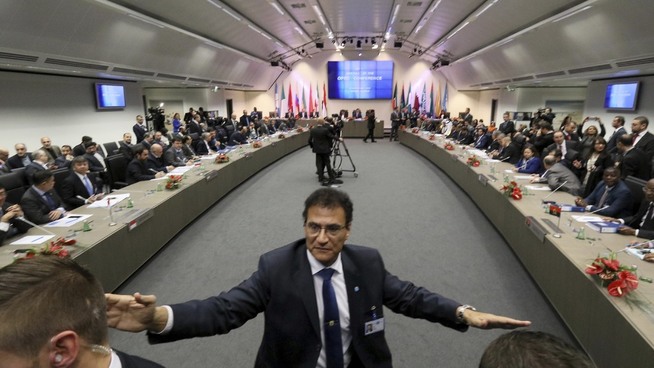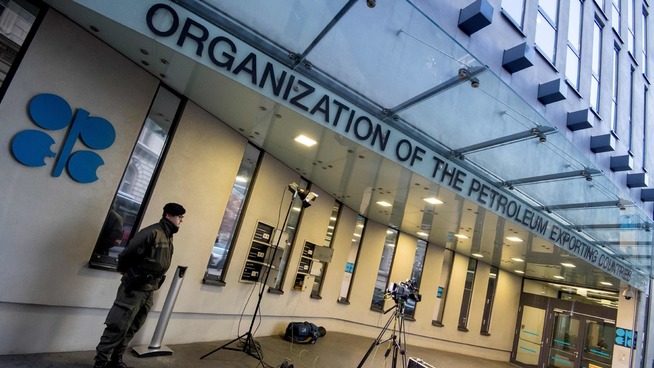Opecs press conference on Wednesday afternoon was delayed for an hour, uncertain of what reason, but eventually came the news the markets had expected.
was scheduled to Opecs secretary general Muhammad Sanusi Barkindo meet the press at 16 together with Qatars energy minister Mohammed Bin Saleh Al-Sada, who is the president of the 171. The Opec meeting in Vienna.
– We are agreed, ” says Al-Sada at the press conference.
– We have come to an understanding that the market must rebalanseres. The to rebalance the market requires bold decisions from Opec, with support from some important countries outside Opec, he said.
Iran
Iraq
Kuwait
Saudi-Arabia
Venezuela
Qatar
Libya
United arab emirates
Algeria
Nigeria
Ecuador
Gabon
Angola
Indonesia walked out of Opec in 2009, restored the membership in January of this year, but is now out again. Gabon went out of Opec in 1995, but went back in July of this year, according to Opec.
Al-Sada confirms that member countries will cut oil production by 1.2 million barrels per day from 1. January. The ceiling in the Opec is on the to 32.5 million barrels per day, ” he says.
Russia cuts also
Of the Opec countries, it is Saudi Arabia that is taking the biggest cut, on 486.000 barrels per day, said Qatars energy minister, who did not go more into the distribution.
Also producers outside Opec will cut production by 600,000 barrels per day. Of this, Russia will cut of 300,000 barrels per day in the reduction. Russia has previously said that it may freeze the production, but would not cut.
Russia supports our point of view, even if the former would just freeze. They bind themselves now to more than that, and decreases with 300,000 barrels per day. Other countries bind themselves too, ” says Al-Sada.
A committee of ministers from Kuwait, Venezuela and Algeria will work together with Opecs secretariat to ensure that the Opec members actually carry out the cuts.
Indonesia, who walked out of Opec in 2009 and again in January of this year, has been suspended from Opec, according to Al-Sada. The reason is that the country is nettoimportør of the oil and can’t participate in the organization’s decision about a cut, ” he says.
oil prices rise
the News from Vienna have affected both currencies, oil prices and stock markets.
the price of oil is up over seven percent in the course of the day, and trades, to around 51 dollars a barrel, from below 48 dollars a barrel in the morning hours.

This is today’s leaks from the Opec meeting
the Rise in oil prices has led to that the Norwegian krone has strengthened against both the dollar and the euro in the course of the day. Wednesday afternoon is a dollar worth 8,51 million.
According to Bloomberg cut Opecs production to 32.5 million barrels per day, but the details are somewhat unclear. The agreement will also involve cuts of 600,000 barrels a day from countries that are not in Opec, writes the news agency.
Arguing about the distribution
Four years of oil prices above usd 100 per barrel from 2011 led to major investments in new production, and it has led to oversupply in the oil market.

HIGHER PRICE: So has the spot price of Brent-oil, developed on Wednesday, after a flood of rumors and reports that the Opec will agree on an agreement about produksjonskutt.
in the Autumn of 2014 began the Opec with Saudi Arabia in the tip to produce more, among other things, to oust us shale oil. The price fell as sharply, and reached earlier in the year, a bunnivå below 30 dollars a barrel, the lowest level since the early 2000s.
Opec countries was in september agreed to cut production to between 32.5 million and 33 million barrels per day. The distribution of the cuts between the countries has been the central theme in the negotiations since.
Among other things, Iran and Iraq, both of which are about to increase production significantly, been skeptical of the to limit or cut their production.
higher oil prices will increase the incomes of oil producers both in the middle East, the USA and Norway, and make them better able to finance investments in future production.
Fear skvis
In the long term there is a risk of oil alert. If the sharp fall in investment in the last two years continues, it can lead to that the production is much lower than the demand around 2020, according to The international energy agency, IEA.

IMPORTANT MEETING: the price of oil has risen much Wednesday, on rumours that Opec countries would agree to cut oil production. This is Saudi Arabia’s oil minister Khalid Al-Falih.
Then the prices can be sky-high.
the Case continues below the advertisement.
Until further notice, it is still too much oil in the market, and if the price were to rise much from current levels, says America’s oil producers are ready at the pumps.
most oil producers in the middle East have large budget deficit and must borrow money to finance its expenditure.
They therefore want a higher oil price, and that they can get to by cutting production.
Saudi Arabia will need around 92 dollars a barrel to balance its budget, while Kuwait, which is the best way in the middle East, needs an oil price of 57 dollars a barrel to get in balance, according to analysts at Wood Mackenzie.
oil income constitutes 90 percent of the revenue to the saudi government, and these fell by 120 billion dollars, or 54 per cent between 2014 and 2015, according to Wood Mackenzie.

OPEC-tops talked the price of oil up before skjebnemøte
Several questions remain
A number of questions remain after Opecs agreement. One of them is whether the Opec countries will do as they have said, or whether they will fall for the temptation to produce more than they have promised.
another question is how quickly american manufacturers can step up their production of shale oil and replace the barrels as Opec cuts.
the Cut may namely be offset by increased american production in the course of half a year’s time, and in addition it will be able to put a damper on global demand, warned IEA chief Fatih Birol earlier this month.
We can well see, with any delay of six or nine months, that the american shale oil will flow out on the market, ” said Birol at a press conference earlier in november.
– This will push down prices, he said.
No comments:
Post a Comment